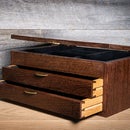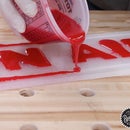Introduction: Quick and Easy Breadboard Ends | How to
Breadboard ends are typically a pain in the butt to join. You're cutting sliding dovetail joints, integral tenons and mortises, and it all becomes quite the process. The reason for this is to compensate for the movement in both the table top, and the breadboard. If this is not done properly the breadboard will fall off over time.
The second issue is strength. Being a table end you want to make sure if someone stands up using the table end, they don't break off the breadboard.
Check out my video tutorial on how I attach my breadboard ends and follow along with the step by step!
If you would like to attempt this project on your own i recommend
Step 1: LAYOUT
In this step you are going to want to lay out your breadboard with the end of your table top. Make sure both are square. You can square your table using a multitude of techniques, but it is crucial to a proper joint that both surfaces are flush.
Once Square reference the bottom of the table, and mark the center of the table and breadboard. Then layout your joinery. I layout a mark on the center of each board of the table top. And I also make notes to the type of joint on the face. (ie. Glue and Tight)
- The center tenon on both the table top and breadboard will be in a tight mortise and glued
- The mortises and tenons on the table top side will all be tight and glued
- The mortises on the breadboard side will all be loose and NOT glued
Step 2: CUT MORTISES
- Cut all of your tight mortises first. Make sure you have the Domino XL Set to the proper setting for this step.
- All mortises on the table top will be tight
- Just the CENTER mortise on the breadboard will be tight, all others will be loose.
Step 3: ADD TENONS
Apply glue to all of the mortises on the table top side. Use a brush to make sure there is plenty of glue in each.
- Then apply your tenons. I use 140mm long x 12mm tenons (these are the biggest Festool sells pre made)
- Hammer in all tenons so they are seated. Wipe away all glue that seeps out of the mortise. You do NOT want glue on the face of the joint
- Liberally apply glue to the center tenon.
Step 4: ADD BREADBOARD
Using a mallet hammer on the bread board until it seats properly.
- Then clamp the breadboard into place
Step 5: DRILL AND APPLY PINS
Mark where each hole will be in the center of the tenon on the breadboard side. (for 140mm tenons use 1/4 the overall dimension, or 35mm)
- Set depth stop (or tape flag) on your drill with the proper diameter for your dowels. Be sure to not drill the entire way through the breadboard. If your tenon was centered properly you should only go 2/3 the way through the board. (For an 1.5" thick top you only need 1" depth of dowel)
- I use 3/8" dowel here (which is probably too big but its all i had on hand. I would recommend 1/4")
- You can precut your dowels to be slightly longer than the depth of your hole or cut them one at a time.
- Hammer your dowel until there is about 1/4" still proud from the top. Apply glue to this last 1/4" only, and finish hammering into hole.
- Let dry (or don't) and use a flush trim saw to cut dowels flush.
YOU'RE DONE!!!
THANK YOU FOR CHECKING OUT THIS PLAN
Check out Mark from the wood whisperers video on how he attached his breadboard in the same way.
3:05 mark https://www.youtube.com/watch?v=b_NTknCCtGE&t=250...











